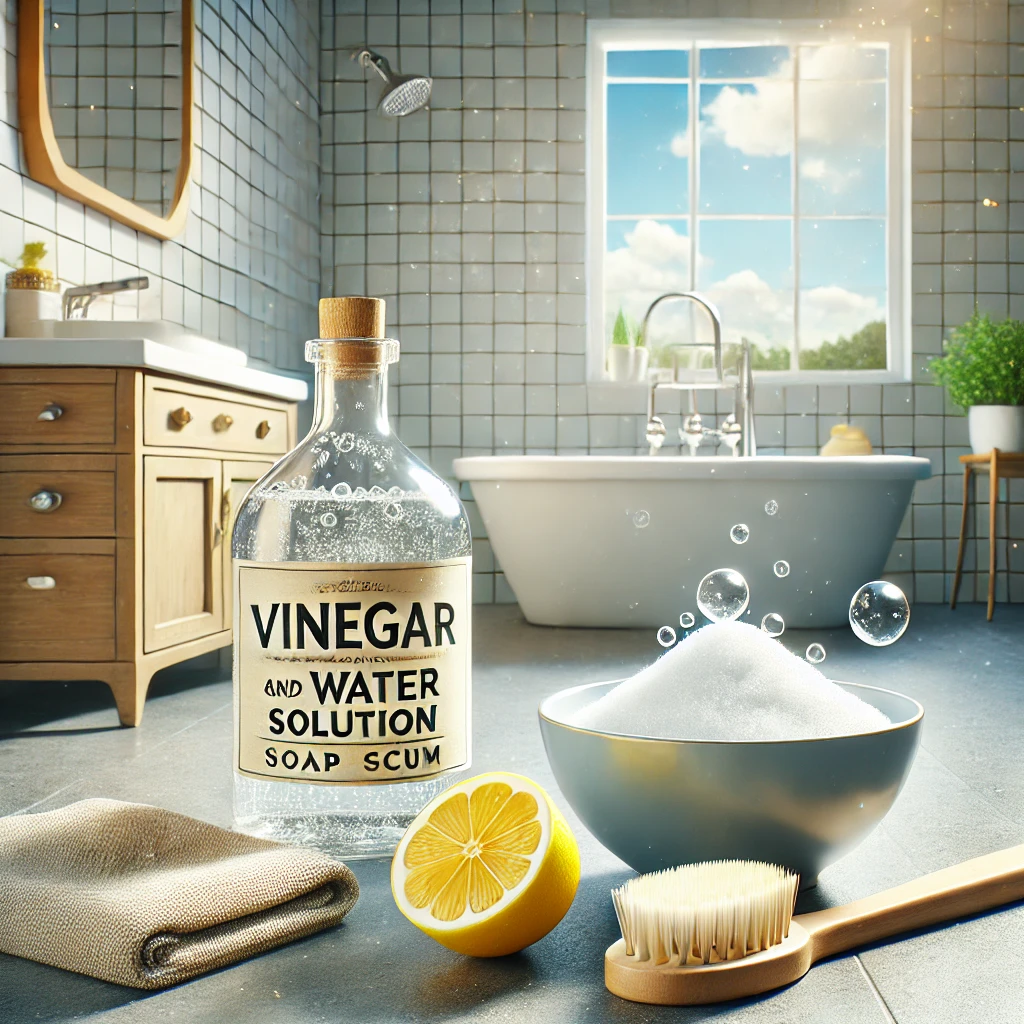
Soap scum is the unsightly, chalky residue that forms on bathroom surfaces, such as shower doors, tiles, and faucets. It results from the combination of soap, hard water minerals like calcium and magnesium, and body oils. When soap reacts with these minerals, it creates a stubborn film that clings to surfaces and becomes increasingly difficult to remove over time. This buildup not only detracts from the cleanliness of your bathroom but can also encourage mold and mildew growth if left untreated.
While many turn to chemical cleaners to combat soap scum, natural cleaning solutions offer several advantages. For one, they are safer for your health and the environment. Harsh chemical cleaners can emit strong fumes that irritate the skin and respiratory system, whereas natural alternatives use gentle, non-toxic ingredients. Additionally, natural solutions are often more cost-effective and just as effective when used correctly. They eliminate the need for expensive specialty products, making them a practical choice for many households.
Removing soap scum is more than just an aesthetic concern—it’s essential for maintaining hygiene. Soap scum traps bacteria and grime, creating an ideal environment for germs to thrive. Over time, this can compromise the cleanliness of your bathroom and potentially impact your health. Moreover, neglecting soap scum can lead to permanent damage to surfaces, as it can etch into glass, dull tiles, and corrode metal fixtures.
By choosing natural methods to tackle soap scum, you not only restore the shine and cleanliness of your bathroom but also take a step toward creating a healthier and more eco-friendly home. The rest of this guide will delve into effective, natural techniques and tips to remove soap scum and prevent its return, ensuring your bathroom remains spotless and inviting.
Common Ingredients for Natural Soap Scum Removal
When it comes to removing soap scum naturally, a handful of everyday ingredients can work wonders. These items are not only safe for your health and the environment but are also incredibly effective at breaking down the stubborn residue that soap scum leaves behind. Here’s a closer look at the key players in your natural cleaning arsenal:
1. White Vinegar:
White vinegar is a cleaning powerhouse and a staple in natural cleaning routines. Its acidic properties help break down the alkaline minerals found in hard water, which are a major component of soap scum. Vinegar dissolves the residue quickly and can also kill bacteria and mold that might accompany soap scum. It’s versatile, affordable, and readily available, making it a go-to ingredient for tackling even the most stubborn buildup.
2. Baking Soda:
Baking soda is another essential ingredient for natural cleaning. Its fine, powdery texture makes it an excellent mild abrasive that can scrub away soap scum without scratching surfaces. When combined with white vinegar, baking soda reacts to create a fizzy action that helps lift stubborn residues, making your cleaning efforts even more effective.
3. Lemon Juice:
Lemon juice isn’t just for flavoring your drinks—it’s a natural disinfectant and deodorizer with a refreshing citrus scent. Its high citric acid content works similarly to vinegar, breaking down soap scum and hard water deposits. Plus, the pleasant fragrance of lemon juice adds a fresh, clean aroma to your bathroom, leaving it not only spotless but also inviting.
4. Castile Soap:
Derived from natural oils like olive or coconut, Castile soap is a gentle yet effective cleaner. While it’s not acidic like vinegar or lemon juice, it helps break down oils and grime, making it an excellent addition to your soap scum removal routine. When combined with other natural ingredients, Castile soap can enhance their effectiveness, leaving surfaces sparkling clean without the need for harsh chemicals.
5. Essential Oils (Optional):
Essential oils, such as tea tree, lavender, or eucalyptus, are optional but highly recommended for their added benefits. Tea tree oil, for example, has antibacterial and antifungal properties, while lavender and eucalyptus provide a soothing, pleasant scent. Just a few drops of essential oil in your cleaning solution can elevate your cleaning experience while contributing to a fresher-smelling space.
Step-by-Step Methods to Remove Soap Scum
With the right natural ingredients, removing soap scum can be straightforward and effective. Below are step-by-step methods using vinegar, baking soda, lemon, salt, Castile soap, and more. These techniques are safe for various surfaces and provide a chemical-free way to restore your bathroom’s cleanliness and shine.
Vinegar and Baking Soda Paste
- Mixing the Paste:
- Combine 1 cup of baking soda with just enough white vinegar to form a thick paste. The mixture will fizz briefly, so add vinegar slowly.
- For extra cleaning power, add a few drops of tea tree or lavender essential oil.
- Applying the Paste:
- Use a soft sponge or cloth to spread the paste onto soap scum-affected areas, such as shower doors, tiles, and faucets.
- Let it sit for 10–15 minutes to allow the acidic vinegar to dissolve the soap scum while the baking soda works as a gentle abrasive.
- Scrubbing and Rinsing:
- Scrub the area with the sponge or a soft-bristle brush, focusing on stubborn spots.
- Rinse thoroughly with warm water and wipe dry with a microfiber cloth to prevent streaks.
Tips for Stubborn Stains:
- For heavily encrusted soap scum, repeat the process and let the paste sit longer—up to 30 minutes—before scrubbing.
- Use a toothbrush to get into tight corners or intricate designs.
Lemon and Salt Scrub
- Preparing the Scrub:
- Cut a fresh lemon in half and sprinkle a generous amount of coarse salt onto the cut surface.
- Using the Scrub:
- Rub the lemon directly onto the soap scum, pressing gently so the salt can act as an abrasive.
- The citric acid in the lemon breaks down the soap scum while the salt scrubs it away.
- Rinsing and Drying:
- After scrubbing, rinse the area with warm water and wipe it dry with a clean cloth.
- This method works particularly well on glass and chrome surfaces, leaving a streak-free shine.
Castile Soap and Vinegar Solution
- Making the Solution:
- Mix 1 cup of warm water, 1 tablespoon of Castile soap, and 1/4 cup of white vinegar in a spray bottle.
- Shake gently to combine the ingredients.
- Applying the Solution:
- Spray the mixture onto the soap scum and let it sit for 5–10 minutes.
- The Castile soap helps loosen dirt and oils, while the vinegar breaks down mineral deposits.
- Cleaning and Rinsing:
- Wipe the area clean with a sponge or cloth, then rinse thoroughly with water.
- Buff dry with a microfiber cloth for a polished finish.
DIY All-Purpose Spray
- Recipe for the Spray:
- Combine 1 cup of white vinegar, 1/2 cup of water, and 1 tablespoon of lemon juice in a spray bottle.
- Add a few drops of your favorite essential oil for fragrance, such as eucalyptus or lavender.
- Using the Spray:
- Shake the bottle before each use and spray generously onto soap scum.
- Allow the solution to sit for 5–10 minutes to loosen the residue.
- Wiping and Polishing:
- Wipe away the scum with a microfiber cloth or sponge.
- For best results, rinse with water and dry immediately to prevent water spots.
Preventing Soap Scum Naturally
The best way to deal with soap scum is to prevent it from forming in the first place. With a few simple practices and natural maintenance techniques, you can keep your bathroom surfaces free from buildup:
1. Rinse Surfaces After Use:
Soap scum thrives on residue left behind after bathing or cleaning. Take a few moments to rinse shower walls, doors, and faucets with warm water after each use. This washes away soap and hard water minerals before they can form a film.
2. Use a Squeegee or Microfiber Cloth to Dry Surfaces:
Drying surfaces immediately after rinsing is crucial to preventing water spots and soap scum. A squeegee is perfect for glass and tiles, while a microfiber cloth works well on other surfaces. These tools help remove excess moisture and leave surfaces spotless.
3. Switch to Soap-Free or Liquid Body Wash:
Traditional bar soap contains fatty acids that combine with hard water minerals to create soap scum. By switching to soap-free or liquid body washes, you can significantly reduce the residue that leads to buildup. Look for biodegradable options to align with eco-friendly goals.
4. Regular Maintenance Tips Using Natural Solutions:
- Use vinegar and water spray (1:1 ratio) once a week to wipe down shower doors, tiles, and fixtures.
- For stubborn spots, sprinkle baking soda on a damp cloth and gently scrub, then rinse.
- Maintain chrome and metal fixtures by rubbing them with half a lemon, then buffing dry.
By incorporating these habits into your routine, you can save time and effort while keeping your bathroom clean and inviting.
Eco-Friendly Tools to Enhance Cleaning
Using the right tools makes natural cleaning more effective and eco-friendly. Here are some sustainable options to consider:
1. Microfiber Cloths for Gentle Scrubbing:
Microfiber cloths are perfect for wiping away soap scum without scratching surfaces. They trap dust, grime, and residue effectively and can be washed and reused multiple times, reducing waste.
2. Natural-Bristle Brushes for Tough Areas:
For hard-to-reach spots or stubborn soap scum, natural-bristle brushes are an excellent choice. These brushes are gentle on delicate surfaces but strong enough to tackle buildup. Opt for brushes with bamboo handles for an eco-conscious alternative.
3. Reusable Spray Bottles for DIY Cleaners:
Investing in reusable glass or BPA-free plastic spray bottles allows you to store and apply your homemade cleaning solutions conveniently. These bottles reduce plastic waste and make natural cleaning a more sustainable practice.
Advantages of Using Natural Solutions
Switching to natural methods for removing soap scum offers several benefits that go beyond just keeping your bathroom clean:
1. Environmental Benefits of Avoiding Harsh Chemicals:
Chemical cleaners often release toxins into the air and water systems, harming ecosystems and contributing to pollution. Natural solutions like vinegar, baking soda, and lemon juice are biodegradable and non-toxic, making them safer for the planet.
2. Cost-Effectiveness of DIY Cleaning Solutions:
Natural cleaning ingredients are inexpensive and readily available, often already in your pantry. DIY solutions reduce the need for pricey commercial products, saving you money in the long run.
3. Safety for Children, Pets, and Those with Sensitivities:
Harsh chemicals can irritate the skin, eyes, and respiratory system, especially for children and pets. Natural alternatives eliminate this risk, ensuring a safer environment for everyone in your home.
Read more: How to remove soap scum from dark tiles
Conclusion
Soap scum may be a common household nuisance, but tackling it doesn’t require harsh chemicals or expensive commercial cleaners. With natural ingredients like vinegar, baking soda, lemon juice, and Castile soap, you can effectively remove buildup while prioritizing the safety of your family and the environment.
Preventing soap scum is equally important and surprisingly simple—rinsing and drying surfaces regularly, switching to soap-free alternatives, and maintaining cleanliness with natural solutions can significantly reduce the time and effort spent scrubbing. Paired with eco-friendly tools like microfiber cloths and reusable spray bottles, these methods ensure your cleaning routine is as effective as it is sustainable.
By adopting natural cleaning solutions, you not only protect your home from harmful residues but also contribute to a greener planet. The cost savings, safety benefits, and environmental impact make this approach an easy and rewarding choice. Whether you’re just starting your journey toward chemical-free cleaning or looking to refine your methods, removing soap scum naturally is a step toward a cleaner, healthier lifestyle for you and your loved ones.
